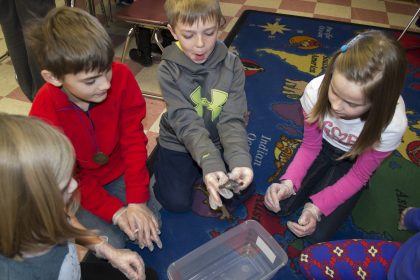
Have an environmental specialist visit your classroom and teach your students about the Port of Baltimore and habitat creation!
As students weigh and measure our Diamondback Terrapin ambassadors, they will learn all about Poplar Island and our other sites. Our standards-based programs are aligned with current curriculum.
*Brand New Lesson!*
Diamonds in the Sand
Recommended Age: Grades K-8
Length: 60+ minutes (time is flexible)
Requires large open space (classroom or outdoors). Table top space can be used if large floor space isn’t available.
What’s it like to study terrapins and terrapin nests as a scientist on Poplar Island? In this hands-on activity, students simulate diamondback terrapin nest research to learn how environmental restoration makes an impact on terrapins and to practice their research and critical thinking skills.
How the Port of Baltimore Is Helping the Diamondback Terrapin
Recommended Age: Grade 3 and up
Length: 30 minutes
In this classroom presentation students will explore the relationship between the Maryland Department of Transportation Maryland Port Administration, habitat restoration in Maryland, and the diamondback terrapin by answering the question, “How did your shoes help create diamondback terrapin habitat?” The format for this program is an engaging PowerPoint presentation that guides students through the process of dredging and the restoration of Poplar Island. We can also give a presentation about the history and construction of our other dredged material containment facilities: Cox Creek, Hart-Miller Island, or Masonville.
Time with the Terrapins
Recommended Age: Kindergarten and above*
Length: 30 minutes
Required equipment: Running water for handwashing
We bring diamondback terrapins to your classroom for this activity. Students are divided into small groups to observe these small turtles and look for the adaptations that help the terrapins survive.
- Learn proper technique and safety precautions for handling reptiles.
- Learn to read notch codes and use a table to identify each turtle.
- Use scales and calipers to weigh and measure the terrapins and record the data in this STEM-based activity!
- Learn how real scientists collect data, make observations, and follow the scientific method.
*Note: students younger than 3rd grade may not touch the turtles.
Felt Board Storytelling: Dredging and Habitat Restoration
Recommended Age: Grades K-2
Length: 30 minutes
Learn about the connection between dredging in the Chesapeake Bay and the restoration of Poplar Island, Hart-Miller Island, Masonville Cove, or the Swan Creek Wetland through interactive felt board stories. In classroom presentations, videos can also be shown to reinforce the concepts of dredging and habitat creation.
Design a Diamondback
Recommended Age: Grade K-2
Length: 30 minutes
In this popular activity students learn about turtle adaptations as they “design” a diamondback terrapin using a volunteer as a life-sized model. The entire class is involved as students read aloud adaptations to build a terrapin piece by piece.
Students will explore:
- Characteristics of turtles vs. other animals
- Adaptations of turtles in general
- Adaptations of diamondback terrapins
Terrapin Travels
Recommended Age: Grades 3-5
Length: 30 minutes
Requires a large playing field (gym or playground)
What’s life like for terrapins in the Chesapeake Bay? Is it easy to survive to adulthood? Terrapin Travels is a life-sized board game that challenges students to survive as a diamondback terrapin. Students roll the die and travel block to block as they face challenges such as predation, habitat loss, and inclement weather.
Poplar Island Pop-up Book
Recommended Age: Grades Pre-K and K
Length: 15 minutes
Large, colorful, moving pages of a story book help explain the concepts of dredging and habitat restoration to younger audiences.
Wetland Parachute
Recommended Age: Grades Pre-K-2
Length: 20 minutes (can be extended)
Requires a large playing field (gym or playground)
Identify native Poplar Island species and use our parachute to act out unique wetland adaptations! Move your body as you learn about the different plants and animals living on Poplar!


